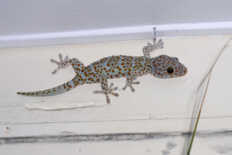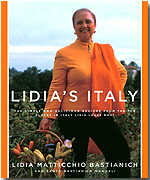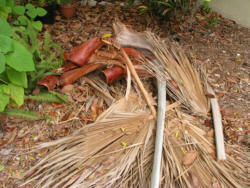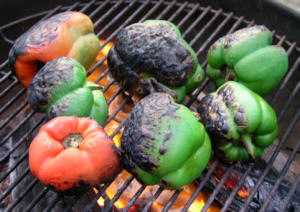Living on $42.00 per Week
July 15th, 2007You may have recently read about a couple of state governors and a congressman or two who have taken up the challenge of living on $21.00 per week for food. That’s the food budget currently available to someone eligible for Federal Food Stamps. We’ve been giving this serious thought and have decided to take up the challenge for ourselves.
For the next week, we’re going to contribute our experiences—what it’s like to live on $21.00 per week. There are two of us, so for this experiment, we’re going to assume that our household is entitled to food stamps and allow ourselves $42.00 for the week.
One of the congressmen, Tim Ryan (D, Ohio), has taken his challenge so far as to eschew lunches at the Capitol—a legitimate perk for all members of Congress. Rep. Ryan’s self-imposed austerity means he will also forgo the comestibles at the fundraisers and cocktail parties that are part of his weekly Washington beat.
We confess we’re less likely to turn down a meal or snack, should we be invited. But we will remember that most people dependent on food stamps do not receive the invitations we get for art gallery openings and wine tastings, where the hors d’oeuvres can be substantial.
We begin this social experiment with an advantage over many food stamp recipients who live with the real threat of hunger and malnutrition. Food is our métier. We’re cooks and we both grew up in families that sat down together for meals virtually every night. We watched our parents and grandparents grow and prepare food. Today, we are self-employed writers who focus on food and culture. We conduct cooking classes, and one of us has worked in a professional kitchen.
The pleasure of food—the buying, preparing, and sharing—is a focal point in our lives. And because we work from home, we try to make time to sit down together for a meal twice per day. We may take breakfast on the run, but lunch and dinner are sacrosanct—times to enjoy conversation as much as the food prepared, however simple the meal may be. And sometimes, it’s very simple—avocado mashed on toast…a hard-boiled egg and tomato salad…
Our everyday meals tend to be what popular media would term “Mediterranean”—in our case, mostly Middle Eastern and Italian. But because we’re both omnivores without food allergies, virtually nothing is off-limits for us. We make frequent forays into Indian, Chinese, and Caribbean cooking as well. And while one of us can inflict serious damage on the dessert bar at an all-you-can eat buffet, neither of us eats a lot of sweets.
Nevertheless, we’ll do our best to stay within the guidelines, and we’ll post our results frequently—at least every other day. Included in our posts, will be recipes for some of what we’ve prepared. We’ll also report any trips for food shopping.
We have a few other advantages over most in real need. As foodies, we begin with a well-stocked larder. For a week’s cooking, we won’t need to buy olive oil, garlic, spices, dried herbs, mustard, vinegar, flour, or many other common pantry items. We already have coffee and tea. Some 1% milk, eggs, and cheese are already in the fridge, and we’ll try to account for those within our $42.00.
Another favorable factor: we own cars. They give us a huge advantage over someone who needs to seek alternative transportation for grocery shopping. As drivers, we can shop at the Red Barn in Bradenton, where a week’s supply of fresh produce can cost less than $10.00. And although it may not be very significant for this short-term challenge, we have a membership at BJ’s. We note it here, because it’s where we bought that 3-litre bottle of Spanish extra-virgin olive oil and the 4 lbs of day-old Ecce Panis ciabatta bread, now in our freezer.
Finally, we have a kitchen—the refrigerator, stove, oven, toaster-oven, and microwave all work. Though we can always pay our bill with FPL, we are frugal with our use of energy.
Links to the rest of the posts in our series:
Living on $42.00 Per Week—Day 1
Living on $42.00 Per Week—Day 2
Living on $42.00 Per Week—Day 3
Living on $42.00 Per Week—Day 4
Living on $42.00 Per Week—Day 5
Living on $42.00 Per Week—Day 6
Living on $42.00 Per Week—Day 7
Living on $42.00 Per Week—Summary
Living on $42.00 Per Week—Redux
Sarasota Night Life
June 19th, 2007We often hear people lament that Sarasota has no night life. And indeed, it seems that the sidewalks do roll up rather early. But if you happen to be out and about on foot—as we were recently—here are a couple of examples of “the inner Sarasota.”

We caught our resident Gecko prowling around the fascia above the lanai. We don’t know much about geckos—for example whether or not they’re entirely nocturnal, or simply photophobic—but we certainly don’t see much more than his head poking out from the eaves above the kitchen during daylight hours. And he seems to do the majority of his vocalizing (along with a chorus of neighborhood cohorts) only after dark.

If that wasn’t enough action for one night, we took a short walk down the street where we live and found these beauties. Night-blooming cereus. The plant is a vine-like cactus. Each flower opens only once, after which it closes and simply hangs from the tree that supports the plant.
We learned later that we could have found some better samples of Moonflowers—as they’re also known—over on Orange Avenue, but it was already past our bedtime.
Tutti a Tavola…
June 5th, 2007
Lidia’s Italy
140 Simple and Delicious Recipes from the Ten Places in Italy Lidia Loves Most
Lidia Bastianich and Tanya Bastianich Manuali
Knopf (April 10, 2007); 384 pages; $35.00
Tutti a Tavola…a Mangiare! This Italian call to the table is familiar to anyone who’s watched Lidia Bastianich’s PBS television shows or read any of her four previous cookbooks. Now she calls us to the table again with her latest, Lidia’s Italy, written in collaboration with her daughter, Tanya Bastianich Manuali, to coincide with her most recent PBS endeavor.
The subtitle of the book, 140 Simple and Delicious Recipes from the Ten Places in Italy Lidia Loves Most, presents an idiosyncratic view of Italian cuisines. It’s no surprise to find two recipes for radicchio in the Treviso chapter, but Lidia’s Tiramisù with limoncello is an unexpected delight. In Tuscany, rather than traipsing through Florence or Siena, she takes us to the Maremma for authentic Bistecca Chianina and a sweet sage pudding. No fewer than five artichoke recipes fill the pages of her Roman chapter, but not one is the ubiquitous Carciofi alla Giudea. The Sicilian classics, Pasta alla Norma and Caponata, make their appearances in Sicily only after we’ve seen an unusual and brilliantly simple antipasto of steamed calamare.
Pellegrino Artusi began to document the regional cuisines of Italy in his self-published La Scienza in Cucina e L’Arte di Mangiar Bene, Kitchen Science, and the Art of Eating Well, in 1891. Beginning with Il Talismano della Felicità, The Talisman of Happiness, in 1928, Ada Boni began to codify these cuisines in even greater depth. The culmination of her efforts, Italian Regional Cooking, appeared in the 1960’s. Soon after, Marcella Hazan and Franco and Margaret Romagnoli began offering their own celebrations of Italy’s wonderfully diverse cuisines in print and on television.
While the menu at Lidia’s original Manhattan restaurant, Felidia continues to reflect her Istrian heritage, Lidia’s Italy affords an intimate, personal look into the cuisines and culture of ten gastronomically distinct areas of Italy. In each chapter, Lidia introduces us to the towns and countryside as we share meals in local restaurants and home kitchens with her friends and colleagues. Hers is a more focused view than we’ve had from either Artusi or Ada Boni.
Beginning in her childhood home, Istria, Lidia and crew work their way though the Italian peninsula with stops in Trieste, Friuli, Padova & Treviso, Piemonte, Maremma, Rome, Naples and Puglia with a stint in Sicily. In each place, Lidia provides a narrative on geography and climate and their significance to the cuisine. The book is liberally sprinkled with photographs taken by Lidia and her friend and fellow Istrian, Wanda Radetti. Additional, full-page photographs are by Christopher Hersheimer, who also contributed to Lidia’s Italian Table, Lidia’s Family Table, and Lidia’s Italian-American Kitchen.
Long observation has led us to the conclusion that most people salivate and do some armchair gallivanting when they get a book like this. We’ve traveled widely in Italy, so the book is a nostalgia trip for us… but we actually do cook and confess our predilection for deeply flavorful yet unpretentious dishes like Papardelle with Long-Cooked Rabbit Sugo and Marinated Winter Squash.
From the Roman chapter, we made Fettuccine with Tomato and Chicken Liver Sauce. Here, Lidia literally teaches us to concentrate. First, we reduce half a cup of white wine, then we add the soaking liquid from dried porcini and reduce that. The liquid from a can of San Marzano tomatoes is drained into the pan and simmered down, too. And if all of this reduction hasn’t been enough, Lidia invites us to “slosh some water around in the tomato can,” add it to the sauce and reduce that!Good, everyday ingredients, the elementary technique of reduction, and attentiveness yielded a superlative dish of richly nuanced flavors.
Lidia reminds her readers accustomed to supermarket displays of Chilean grapes and apricots in March, that recognition of seasonality is crucial to a grasp of Italy’s cuisines: “A trip to this market [Campo dei Fiori in Rome]—for that matter, to any market in Italy—will give you a good indication of the season, of the local flavors, and of what most of the Roman families will be having for dinner that evening.”
Or not having…
As Floridian writers, we feel disadvantaged that half the book is set in northern Italy, with corresponding recipes that call for ingredients woefully out of season here in June. We love the hearty fall and winter dishes of the north, but we just can’t get those autumnal bitter greens and root vegetables right now, because (to quote Cole Porter) “it’s too darn hot.”
Nevertheless, peppers remain in season here, so we roasted several to cook the Piemontese antipasto, Roasted Pepper Rolls Stuffed with Tuna. The stuffing, redolent of anchovies and capers, makes a delightful tuna salad in its own right, but in combination with the roasted peppers, it’s divine.
Although it didn’t seem practical for this review to prepare a dish from each of Lidia’s ten favorite places, we wanted to do at least one from the south, in part for its unconventional preparation. We chose Steamed Calamare, from Lidia’s Sicilian friend, Manfredi Barbera. Rings and tentacles of small calamare are steamed until just tender over an infusion of lemon rind and bay leaves. They are then tossed with lemon juice, grated orange rind, pepperoncino, parsley, and olive oil. The result is superb, a dish in which each component is clearly discernible and harmonious with all the others.
Lidia’s success as a restaurateur and author of four cookbooks was surely a factor in her publishers allowing her the freedom to write so engagingly. Her culinary vocabulary can be endearingly quirky: we are told to “tumble” squid and to “perk” soups… but as cooks, we know what she means.
David Nussbaum seems to have stayed close as a literary collaborator, but Lidia and her daughter, Tanya, never lose their own distinctive voices.
Tanya leads tours in Italy, and the cookbook is graced by her travel notes on some remarkable and little-known historical attractions. Mama Lidia’s words on food are always clear and encouraging. Above all, they are words of passionate conviction—that the preparation and sharing of food are among life’s most rewarding activities.
###
Reviewed by Holly Chase and Skip Lombardi
Palmetto-Roasted Peppers
May 13th, 2007
One of the great culinary finds for me here in Sarasota has been palm fronds. It turns out that they make excellent fuel for the Webber grill.
Of course, the price is right, and availability is no problem. I rarely need to forage farther than the street where I live to find an adequate supply. Once cut to size, the ribs and bases of the palmetto ignite with a piece of crumpled newspaper, and they burn at a very high temperature.
I’ve found one drawback, and that’s predictability. It seems some palm fronds burn faster than others. So I’ve remedied that by adding a half-dozen hardwood charcoal briquettes to the fire.
For grilling meats, the smokiness is great. I find it as distinctive as hickory or maple. But I’ve found another characteristic of palmetto that is unparalleled in my previous experience: it’s superb fuel for roasting bell peppers.
I’ve had problems in the past with either all hardwood briquettes, or with various other types of wood, where the peppers’ skins would simply fuse with the flesh. In five batches of peppers of varying size and thickness now, the charred skin peels off quickly and easily. In fact, for me anyway, palmetto has given new life to an Italian classic.
 Roasted peppers are a staple of the southern Italian antipasto platter we all know, but they also make a terrific addition to sandwiches such as a panino prosciutto and mozzarella. Tony restaurants have recently been featuring roasted peppers in soups with tomato and basil. Roasted peppers are also the sine qua non for a dish of Pasta alla Napoletana.
Roasted peppers are a staple of the southern Italian antipasto platter we all know, but they also make a terrific addition to sandwiches such as a panino prosciutto and mozzarella. Tony restaurants have recently been featuring roasted peppers in soups with tomato and basil. Roasted peppers are also the sine qua non for a dish of Pasta alla Napoletana.
Roasting peppers is not rocket science. You need only a charcoal grill or a broiler to roast peppers. Then it’s just a matter of shepherding them though the process. This is a time, though, to give complete attention to the task at hand.
One moment too long on the grill yields pepper-flavored charcoal. So let the phone ring through to voicemail, and free yourself from other potential distractions for several minutes, and you’ll be rewarded with one of the great treats of the Italian table.
Notes:If you’re using palm fronds, use the ribs and base only. Cut the top, leafy part away, and bring it to the curb on yard waste day.
In the recipe that follows, I’ve simply made reference to a charcoal fire. Of course this will work with all charcoal, or under the broiler in your kitchen too.
Ingredients:
4 – 6 Sweet bell peppers
4 Cloves garlic, peeled, and thinly sliced
1 Tbs. Capers, washed, and drained
4 Anchovy filets, preferably dried, salted anchovies, rinsed, drained, and chopped into quarter inch pieces
Olive oil
Salt & freshly-ground black pepper
Preparation:
Start a fire in a charcoal grill, or pre-heat the broiler. When the fire is ready, add the peppers without crowding them. Allow them to char on the side facing the fire, inspecting them from time to time. When the skin has blackened and has begun to bubble away from the flesh, turn them to expose another uncooked surface to the fire. Continue cooking them in this manner until they are uniformly blackened all around, then, stand them on end to blacken them top and bottom.
As each pepper is done, remove it to a paper bag to rest. When the last pepper is done and added to the bag, seal the top by folding it over several times, and allow the cooked peppers to rest for fifteen minutes.
For peeling the peppers, I observe a tradition I learned from my grandfather: I open a newspaper and simply rub the skins off onto the sports section. You could do it over a sink or a wastebasket, but do it in a place where you can control where the skins go. In his later years, my grandfather was also notorious for getting charred pepper skins all over the kitchen cabinets. If you find a particularly tough piece of skin that won’t come off easily, try loosening it with the back of a paring knife; failing that, try a vegetable peeler.
When the peppers are peeled, cut off their tops, then remove and discard the seeds and pod. Cut the peppers lengthwise into strips about one inch wide and place in a glass or ceramic bowl. Add the garlic, capers, and anchovies. Toss to combine the ingredients, then add enough olive oil to coat the peppers. Don’t soak them; just coat them with the oil. Taste for salt and pepper, and add them to your taste. Leave the peppers to marinate at room temperature for two hours.
If you’re not going to use the peppers immediately, cover the bowl with plastic wrap, or transfer to a glass jar and store them in the refrigerator. The peppers will keep, refrigerated, for at least a week.
The peppers will be adequate as a component of an antipasto for twelve, or make sandwiches for six. But if there’s a good ball game on television and you have a loaf of good Italian bread and you’re all alone…well, all bets are off.



